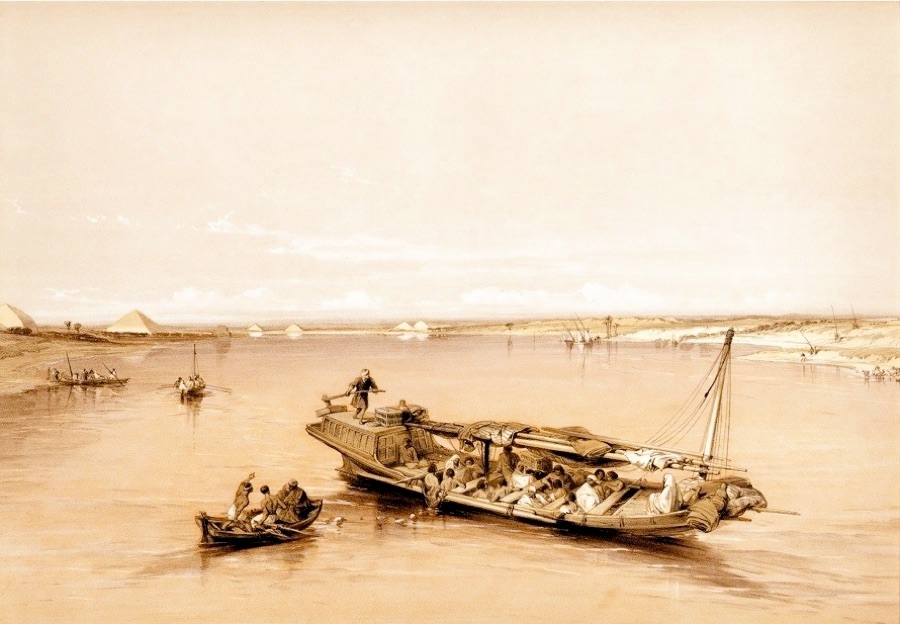VIEW LOOKING TOWARDS THE PYRAMIDS OF DASHOUR AND SACCARA,
WITH A SLAVE-BOAT ON THE NILE.
THE breadth of the Nile, and the flat character of its banks and its valleys, about twenty miles above Cairo, are particularly observed in the neighbourhood of the Pyramids of Dashour and Saccara - structures which are highly characteristic of their locality. Those of Saccara are the most distant in the view ; they are chiefly built of brick, one only being wholly of stone. The base of the largest is a parallelogram, about three hundred and fifty feet long on its north and south faces, and three hundred and ninety-four on its east and west sides. It is built in degrees, or stages, and is surrounded by an inclosure. Besides this Great Pyramid, there are ten others, of smaller dimensions. Some of these Pyramids were opened by the Baron von Minutoli in 1821, and in 1837, by Mr. Perring, whose surveys and researches into the construction of these extraordinary works are fully detailed in Colonel Vyse's Pyramids of Gizeh.
The stone Pyramids of Dashour form the group nearest to the observer in the view. There is a striking peculiarity in the form of the southernmost of these: its summit has been finished at a different angle from that of the faces with which it was commenced: and Wilkinson thinks, from its being the only one of this form, that the angle was depressed to complete it more speedily. The change greatly diminished the height which it would have had if the original angle had been continued. Its base, measured by Colonel Vyse, is seven hundred feet square. This Pyramid was entered by Mr. Melton, an English traveller, in 1660; and again, twenty years later, by M. le Brun. In 1763 it was visited by Mr. Davison, whose researches in Egypt gave his name to a chamber which is discovered in the Pyramid of Cheops, the largest of the group of Geezeh. The last examination of the Pyramids of Dashour was by Mr. Perring and Colonel Vyse; by whom some matters interesting to the Egyptian antiquary were discovered, which are fully related in the Appendix to Colonel Vyse’s Work.
A picturesque interest has been given to the scene by Mr. Roberts’s introduction of a Slave-Boat, which he thus describes in his Journal: - “A boat of a very different description came alongside of mine this afternoon: it was a slave-boat, of small dimensions for its purpose, laden with a cargo of female slaves from Kordafan, and owned by a hoary villain, a Greek, who had the effrontery to tell me that he was a Christian. Except that they had been torn from their friends - an evil distressing enough in itself - the slave-trade here seems unaccompanied by any of the horrors which attend that infernal traffic in the passage from the western coast of Africa; for, except the confinement in the small space allotted to them in the boats, they are little exposed, in a climate like this, to inclement weather. The trade must be profitable, since such a journey could be advantageously taken with eleven only of these poor wretches for the market. Five were of a dark copper colour, and beautifully formed; and six were negresses, all young and in their prime, their hair plaited as in Nubia, but free from the villanous grease and from the smell which generally accompanies its use there. A thin dirty sheet was their only covering; and as the evening set in they were wrapped closer, and huddled more together. The space was too narrow to lie in at length: they sat with their knees up to their chins and face to face. The Greek, in hopes of a customer, pointed out the best of them to me, and descanted on their points with the skill of a jockey. Some were modest and shy, others tittered and seemed much amused with my costume, a blouse, and trousers not one-third the width of a Turk’s. The best of these poor creatures was worth eighteen or twenty pounds sterling. I regretted that it had too few words of Arabic or Greek to tell the old rascal how much his occupation was abhorred in England.”
Vyse’s Pyramids of Gizeh. Wilkinson’s Egypt and Thebes. Roberts’s Journal.


